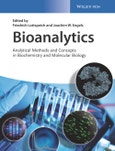The presentation includes frequent cross-references in order to highlight the many connections between different techniques. The book provides a bird's eye view of the entire subject and enables the reader to select the most appropriate method for any given bioanalytical challenge. This makes the book a handy resource for students and researchers in setting up and evaluating experimental research. The depth of the analysis and the comprehensive nature of the coverage mean that there is also a great deal of new material, even for experienced experimentalists.
The following techniques are covered in detail:
- Purification and determination of proteins
- Measuring enzymatic activity
- Microcalorimetry
- Immunoassays, affinity chromatography and other immunological methods
- Cross-linking, cleavage, and chemical modification of proteins
- Light microscopy, electron microscopy and atomic force microscopy
- Chromatographic and electrophoretic techniques
- Protein sequence and composition analysis
- Mass spectrometry methods
- Measuring protein-protein interactions
- Biosensors
- NMR and EPR of biomolecules
- Electron microscopy and X-ray structure analysis
- Carbohydrate and lipid analysis
- Analysis of posttranslational modifications
- Isolation and determination of nucleic acids
- DNA hybridization techniques
- Polymerase chain reaction techniques
- Protein sequence and composition analysis
- DNA sequence and epigenetic modification analysis
- Analysis of protein-nucleic acid interactions
- Analysis of sequence data
- Proteomics, metabolomics, peptidomics and toponomics
- Chemical biology
Table of Contents
Preface XV
Introduction XIX
Part I Protein Analytics 1
1 Protein Purification 3
2 Protein determination 23
3 Enzyme Activity Testing 35
4 Microcalorimetry 47
5 Immunological Techniques 63
6 Chemical Modification of Proteins and Protein Complexes 107
7 Spectroscopy 131
8 Light Microscopy Techniques – Imaging 181
9 Cleavage of Proteins 207
10 Chromatographic Separation Methods 219
11 Electrophoretic Techniques 243
12 Capillary Electrophoresis 275
13 Amino Acid Analysis 301
14 Protein Sequence Analysis 313
15 Mass Spectrometry 329
16 Protein–Protein Interactions 381
17 Biosensors 419
Part II 3D Structure Determination 431
18 Magnetic Resonance Spectroscopy of Biomolecules 433
19 Electron Microscopy 485
20 Atomic Force Microscopy 519
21 X-Ray Structure Analysis 529
Part III Peptides, Carbohydrates, and Lipids 553
22 Analytics of Synthetic Peptides 555
23 Carbohydrate Analysis 571
24 Lipid Analysis 613
25 Analysis of Post-translational Modifications: Phosphorylation and Acetylation of Proteins 645
Part IV Nucleic Acid Analytics 663
26 Isolation and Purification of Nucleic Acids 665
27 Analysis of Nucleic Acids 681
28 Techniques for the Hybridization and Detection of Nucleic Acids 719
29 Polymerase Chain Reaction 755
30 DNA Sequencing 785
31 Analysis of Epigenetic Modifications 817
32 Protein–Nucleic Acid Interactions 831
Part V Functional and Systems Analytics 873
33 Sequence Data Analysis 875
34 Analysis of Promoter Strength and Nascent RNA Synthesis 895
35 Fluorescent In Situ Hybridization in Molecular Cytogenetics 917
36 Physical and Genetic Mapping of Genomes 925
37 DNA-Microarray Technology 945
38 The Use of Oligonucleotides as Tools in Cell Biology 959
39 Proteome Analysis 977
40 Metabolomics and Peptidomics 1023
41 Interactomics – Systematic Protein–Protein Interactions 1033
42 Chemical Biology 1041
43 Toponome Analysis 1057
Appendix 1: Amino Acids and Posttranslational Modifications 1073
Appendix 2: Symbols and Abbreviations 1075
Appendix 3: Standard Amino Acids (three and one letter code) 1081
Appendix 4: Nucleic Acid Bases 1083
Index 1085








